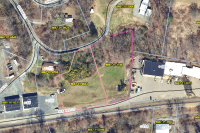Muddy math plays into sediment calculations
Calculating the volume of mud that washed downstream with the collapse of a large earth dam at Balsam Mountain Preserve has emerged as a source of contention between the developer and state and federal agencies.
The packed earth dam — 36-feet high at its tallest point — sequestered a pond used to irrigate the development’s golf course. It collapsed in early June.
Balsam Mountain Preserve is now charged with a massive clean-up effort to remove sediment from eight miles of streams. But first, the developer must calculate how much mud went into the creeks. The majority came from the earth dam itself, pushed downstream by the wall of water behind it. Balsam Mountain Preserve hired an engineer to calculate the volume and arrived at 999 cubic yards.
But state and federal agencies overseeing the clean-up seem skeptical of this number.
Bryan Thompkins with the U.S. Fish and Wildlife Service did his own cursory calculations — length multiplied by width multiplied by height of the missing section of the dam — and came up with a good deal more than what Balsam Mountain Preserve’s engineer calculated.
So far, Balsam Mountain Preserve has only provided the raw number — 999 cubic yards — but has not shown how the figure was calculated. Thompkins and representatives from the other agencies have asked Balsam Mountain Preserve’s engineer to share his calculations: similar to “showing your work” on a school math test. So far, they haven’t gotten an answer.
Like Thompkins, Kevin Barnett with the N.C. Division of Water Quality is also questioning the calculation.
“This agency will ask for additional information to support the claims made in the (engineer’s) report,” Barnett said.
The number is important. It will provide the baseline for how much sediment Balsam Mountain Preserve has to remove from downstream creeks.
Balsam Mountain Preserve said it is relying on what its engineer, William Lapsley and Associates, has come up with.
“That is the number that the engineers and other consultants have determined,” said Chris Crouch, golf course manager who is now overseeing clean-up efforts.
Another part of the equation is the volume of mud scoured from the creek banks below the dam break. The surge of mud and water from the dam gouged the stream channels below, picking up more sediment as it went. That, too, has to be included in the equation, according to the agencies.
But so far, that number hasn’t been calculated.
“It is impossible to determine the quantities removed from the streambed and banks due to scouring,” according to the engineer’s report.
That’s not good enough, according to the agencies.
“We believe there is a way to at least get a reasonable determination of the amount of sediment that was scoured. We are going to ask for them to go back and do that,” Barnett said.
What comes out
If calculating how much sediment went into the creeks seems tough, calculating how much has been removed is proving difficult as well. Balsam Mountain Preserve claimed in a recent progress report to the agencies that it has removed 1,078 cubic yards of sediment so far.
The claim is wildly overreaching, however, according to the agencies. In reality, only 60 cubic yards had physically been removed from the creeks at the time of the report two weeks ago — 40 from Sugarloaf and 20 from Scotts Creek.
The remainder of the claim — 1,018 cubic yards — wasn’t actually removed at all. Balsam Mountain Preserve claims a great deal of sediment washed up and settled on the creek banks as it moved downstream. The developer sprayed hydroseed on these creek banks, claiming to have stabilized more than 1,000 cubic yards worth of deposited sediment in the process.
But the agencies disagree. The first problem with the claim is that the creek banks receiving hydroseed weren’t home to deposited sediment at all, they said. Some of the hydroseeded banks were nearly vertical, for example.
“Sediment won’t deposit on vertical banks,” Thompkins said.
The hydroseeded banks also sport protruding rocks and roots and clearly are not covered with a layer of deposited sediment.
“The Division of Water Quality believes these areas are not depositional areas of lost sediment from the dam failure and therefore are not considered part of the sediment accounting for the restoration of the site,” Barnett said.
According to Balsam Mountain Preserve’s calculations, it has already captured more sediment than went in to the creeks from the dam break. Crouch said Balsam Mountain Preserve is not suggesting that its work in sediment removal is done, however.
“It would appear that way from the numbers, but we want to be cooperative with the agencies and do what we need to do,” Crouch said. “We have continued our efforts and have not slowed down one bit because of that number. We haven’t said ‘OK we’re done.’ Our efforts are continuing as strong as they ever have been.”





